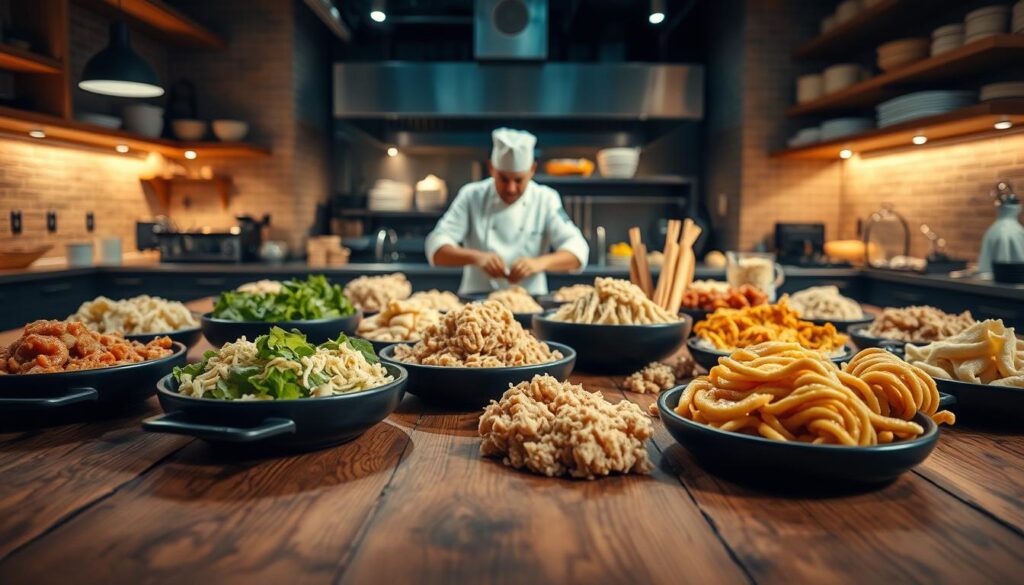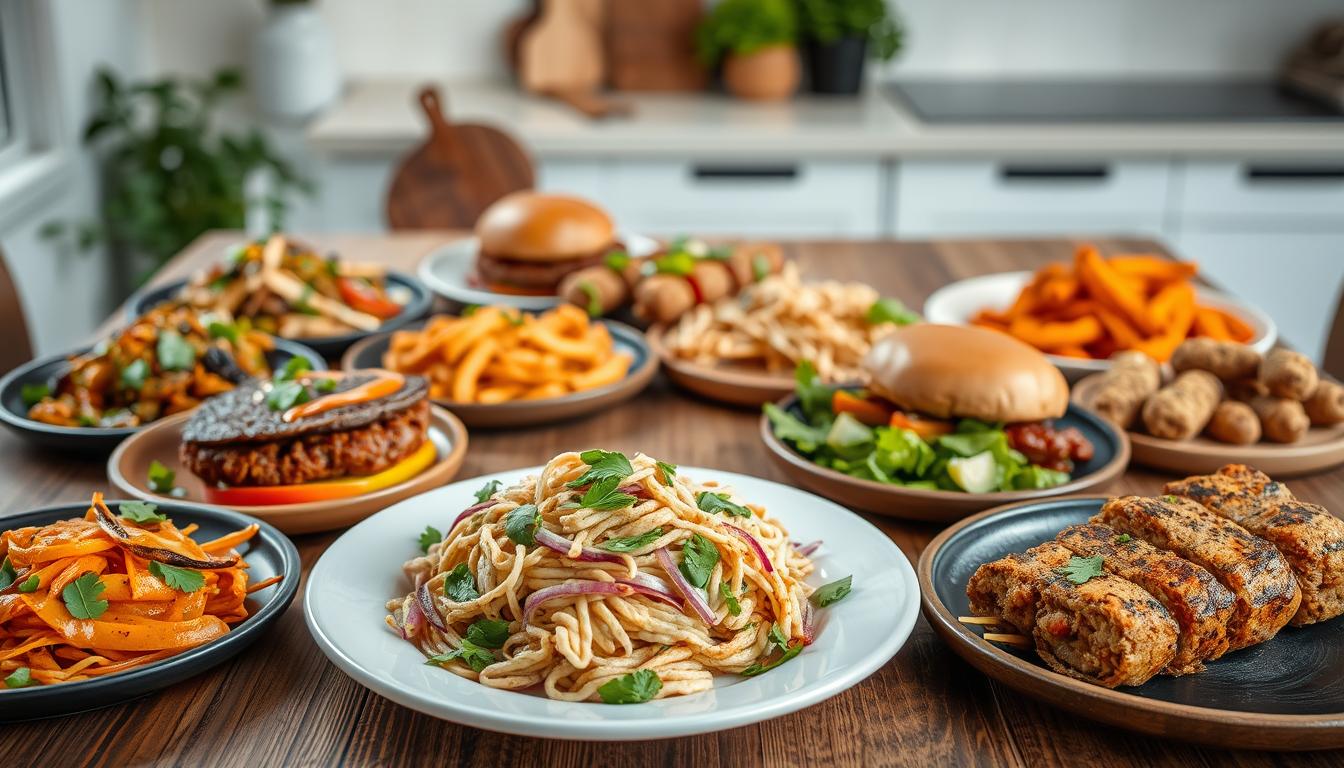Looking for a vegan protein that’s both tasty and filling? Seitan is your answer. It’s a meat substitute that’s changing the game for plant-based diets. It offers hearty, nutritious meals without sacrificing flavor or texture.
Finding a protein that really satisfies can be tough. But seitan is a game-changer. It mimics meat textures and soaks up flavors, making it a must-have in your kitchen.
Whether you’re vegan or just looking to eat less meat, seitan is a great choice. It’s packed with protein and can be used in everything from quick dinners to fancy dishes. These seitan recipes will change how you cook meat substitutes.
Key Takeaways
- Seitan provides up to 22 grams of protein per serving
- Low in calories and fat, making it heart-healthy
- Versatile ingredient adaptable to multiple cuisines
- Easy to prepare and customize with various marinades
- Suitable for meal prepping and freezing
Understanding Seitan: The Plant-Based Protein Powerhouse
Seitan is a game-changer in plant-based cooking. It’s made from wheat gluten and is packed with protein. This makes it a great choice for those who want meatless meals.
Seitan is a standout in plant-based nutrition. Its special makeup makes it a top choice for those looking for a meat substitute. It’s loved by food lovers everywhere.
What Makes Seitan a Superior Meat Alternative
Seitan has a nutritional edge over other proteins. Here’s why it’s so special:
- High protein content: Contains 25-30 grams of protein per 100 grams
- Low in fat: Less than 5 grams of fat per 100 grams
- Cholesterol-free and heart-healthy
- Extremely versatile in cooking
Nutritional Benefits of Wheat Gluten
Wheat gluten is a powerhouse of plant-based protein. It’s perfect for replacing meat in many dishes. Here’s what it offers:
| Nutrient | Amount per 100g |
|---|---|
| Protein | 25-30g |
| Carbohydrates | Less than 10g |
| Fat | Less than 5g |
History and Origins of Seitan
Seitan has a long history in Asian cuisine, especially in vegetarian Buddhist traditions. It was first made for monks as a protein source. Now, it’s loved worldwide for its flavor and texture.
But, people with gluten sensitivity need to be careful. Always talk to a nutritionist before adding seitan to your diet.
Essential Ingredients and Equipment for Making Seitan
Making tasty mock meat for your vegetarian dishes begins with knowing the right ingredients and tools. Seitan needs specific parts to turn wheat gluten into a protein-rich meat substitute.
- Vital wheat gluten (primary ingredient)
- Vegetable broth
- Liquid aminos
- Nutritional yeast
- Seasonings and spices
Choosing high-quality ingredients is crucial for perfect seitan. Vital wheat gluten is the main ingredient, offering about 30 grams of protein per serving.
“Great seitan starts with great ingredients” – Vegan Cooking Experts
Here’s what you need for seitan preparation:
- Food processor
- Mixing bowls
- Steamer or pressure cooker
- Cutting board
- Measuring cups and spoons
Seitan preparation takes about 1 hour and 10 minutes. You’ll spend 10 minutes preparing, 30 minutes cooking, and 20 minutes resting. Each serving has about 280 calories, making it a healthy meat alternative.
Pro tip: Chill your seitan overnight to enhance its texture and taste. It can keep for up to 2 weeks in the fridge.
Basic Seitan Recipes for Beginners
Exploring meat alternatives is exciting, especially with high-protein recipes like seitan. For beginners, learning basic seitan recipes is a great start. These recipes make delicious meat alternatives in your kitchen.
Before starting your seitan cooking journey, here are some key preparation tips:
| Recipe Specification | Details |
|---|---|
| Total Weight | 450 g |
| Preparation Time | 15 minutes |
| Cooking Time | 45 minutes |
| Total Protein per Serving | 41 g |
Classic Seitan Cutlets
Making classic seitan cutlets is easy. You’ll need:
- 200 g vital wheat gluten flour
- 30 g chickpea flour
- 160 ml water
- 2 tbsp vegetable oil
- 1 tbsp red wine vinegar
Simple Steamed Seitan
Steaming makes seitan tender and protein-packed. Mix ingredients, shape into a log, and steam until done.
Boiled Seitan Patties
Boiling seitan patties gives a unique texture. It lets you add flavors during cooking. Cook for about 45 minutes to keep taste and texture perfect.
Advanced Seitan Recipes for Culinary Enthusiasts

Take your plant-based cooking to the next level with these advanced seitan recipes. They turn simple wheat gluten into gourmet dishes. You’ll learn to make meat alternatives that wow even the pickiest eaters.
Creating professional seitan recipes needs both precision and creativity. Here are some key techniques to master:
- Double cooking methods for enhanced texture
- Complex flavor layering techniques
- Specialized protein manipulation
- Intricate shaping and molding approaches
By mixing different ingredients, your seitan can mimic meat textures. For example, adding rice or chickpea flour to vital wheat gluten creates more complex proteins.
Here are some advanced strategies for building proteins in your dishes:
- Incorporate nutritional yeast for deeper umami flavor
- Experiment with multiple seasoning layers
- Use precise kneading techniques to develop protein networks
- Implement varied cooking temperatures for texture variation
Professional chefs suggest a mix of 1 ¾ cups vital wheat gluten and ¼ cup rice flour for the best texture. Marinating your seitan for at least an hour boosts its flavor and makes it taste more like meat.
Mastering advanced seitan recipes transforms plant-based cooking from simple sustenance to culinary art.
Flavoring Techniques and Marinades for Perfect Seitan
Turning seitan into a flavorful vegan protein is all about the right marinating and seasoning. Seitan’s neutral taste lets you get creative with flavors from all over the world.
Marinating is key to making seitan taste amazing. It’s about adding strong flavors that make every bite a delight.
Asian-Inspired Marinades
Asian flavors are perfect for seitan. Here’s what you can use:
- Soy sauce (3 tablespoons)
- Thai sweet chili sauce (2 tablespoons)
- Minced garlic (4-6 cloves)
- Fresh ginger
- Sesame oil
Barbecue and Smoky Flavors
For smoky tastes, liquid smoke is a game-changer. Just a few drops can make your seitan taste like BBQ. Mix it with:
- Smoked paprika
- Brown sugar
- Apple cider vinegar
- Worcestershire-style sauce
Mediterranean Seasonings
Mediterranean herbs add bright, aromatic flavors to seitan. Try these:
- Fresh parsley (1 tablespoon chopped)
- Oregano
- Rosemary
- Olive oil
- Lemon juice
Pro tip: Always marinate seitan for at least 1 hour to ensure maximum flavor absorption. The longer the marinating time, the more intense the taste will be.
Creative Ways to Prepare and Cook Seitan Recipes
Exploring vegetarian cuisine opens up exciting culinary possibilities with mock meat alternatives like seitan. This versatile protein source allows you to transform your meals with innovative cooking techniques. These techniques bring incredible flavor and texture to your plate.
Seitan offers multiple cooking methods that can elevate your plant-based dishes. Here are some creative approaches to preparing this delicious protein:
- Grilling: Achieve a smoky char by marinating seitan and grilling it with your favorite seasonings
- Breading and Frying: Create crispy “chicken” strips or cutlets with a crunchy exterior
- Slow Cooking: Develop rich, tender textures in stews and hearty dishes
- Stir-Frying: Quick-cook seitan with vegetables for fast, nutritious meals
Your seitan recipes can span global cuisines, from spicy tacos to aromatic curries. With only 100 calories per 3-ounce serving and 21 grams of protein, seitan makes an excellent meat replacement. It doesn’t compromise on nutrition or taste.
Experiment with marinades and seasonings to transform seitan into everything from “meatballs” to deli-style sandwich slices. The key is understanding how this mock meat absorbs flavors. This makes it an incredibly adaptable ingredient in vegetarian cuisine.
Tips for Achieving the Perfect Seitan Texture
Getting the right texture for your seitan is key. It turns a simple protein into a tasty dish. With the right techniques, you can make it perfect.
Mastering seitan involves several important factors. These affect its texture and taste. Knowing these will help you make top-notch plant-based proteins at home.
Kneading Techniques for Optimal Texture
Kneading is crucial for seitan’s texture. Chefs suggest:
- Knead for 2-3 minutes for a firm texture
- Don’t over-knead to avoid a rubbery feel
- Use gentle, even motions to spread the gluten
Cooking Methods Comparison
Various cooking methods change seitan’s texture. Here’s a quick look:
| Cooking Method | Texture Result | Recommended For |
|---|---|---|
| Steaming | Soft, tender | Delicate dishes |
| Boiling | Chewy, dense | Hearty meals |
| Baking | Firm, crispy edges | Cutlets and sandwiches |
Solving Common Texture Problems
When making meatless meals with seitan, texture issues can arise. Here are quick fixes:
- Rubbery texture: Reduce kneading time
- Too soft: Increase cooking time
- Bland taste: Add more seasonings or soy sauce
By mastering these techniques, you’ll take your seitan from basic to amazing. You’ll create protein-rich meals that are satisfying and delicious.
Meal Planning with Seitan: Weekly Recipe Ideas

Adding seitan to your meals can change your week. It’s a protein-rich food that makes your meals tasty and healthy. You’ll feel full and energized all week.
Plan your meals with seitan to get a variety of flavors and nutrients. Seitan has about 25 grams of protein per 100 grams. This helps build muscle and keeps you going all day.
- Breakfast: Seitan scramble with nutritional yeast and vegetables
- Lunch: Seitan stir-fry with mixed vegetables
- Dinner: Roasted seitan cutlets with herb marinades
- Snacks: Seitan protein bites
Preparing seitan is quick and easy. You can make a batch in 20 minutes with just six ingredients. The trick is making a dough that’s elastic and perfect for cooking.
Here are some tips to make meal planning with seitan easier:
- Make big batches of seitan on weekends
- Keep it in airtight containers for easy access
- Try different marinades and seasonings
- Change up how you cook it to avoid getting bored
Using seitan in your meals means you get a protein that’s good for your heart. It’s also rich in iron, which helps carry oxygen and gives you energy.
Conclusion
Exploring seitan recipes has shown us a strong plant-based protein. It’s as good as chicken or beef but better for the planet. With about 21 grams of protein per serving, it’s a great choice for those looking for a meat substitute.
Seitan is not just good for you; it’s also good for the Earth. Making wheat-based seitan produces much less CO2 than raising chicken. This means it’s a big step towards reducing our carbon footprint.
Trying out different ways to cook seitan can change how you see food. You can steam, bake, or even marinate it. Homemade seitan can be stored in the fridge for up to 5 days or frozen for three months. This way, you always have a tasty, eco-friendly protein option.
Using seitan is more than just cooking; it’s a choice for your health and the planet. Start trying out these recipes and see how tasty and beneficial plant-based eating can be.
FAQ
What exactly is seitan?
Seitan is a plant-based protein made from wheat gluten. It’s the main protein in wheat. To make it, wheat flour dough is washed to remove starch, leaving gluten. It’s chewy, like meat, and great for those who don’t eat animal products.
Is seitan a healthy protein source?
Yes, seitan is a good choice for protein. It has about 25 grams of protein per 3.5-ounce serving and is low in fat. But, it’s not a complete protein, so it’s best with other plant-based proteins. It’s great for vegetarians and vegans.
Can people with gluten sensitivities eat seitan?
No, seitan is not safe for those with gluten intolerance or celiac disease. It’s made from wheat gluten, which is high in gluten. People with gluten sensitivities or wheat allergies should avoid it and look for other protein sources.
How do I store homemade seitan?
Keep homemade seitan in an airtight container in the fridge for up to 7 days. You can also freeze it for up to 3 months. Wrap it tightly in plastic wrap or use a freezer-safe container to prevent freezer burn. Thaw it in the fridge before reheating or using.
What’s the best way to cook seitan?
Seitan can be cooked in many ways. Try steaming, baking, grilling, pan-frying, or simmering. Each method gives a different texture and flavor. Find the method that works best for your recipe.
Can I make seitan without vital wheat gluten?
While vital wheat gluten is key for seitan, traditional methods use wheat flour. For home cooking, vital wheat gluten flour is the easiest and most reliable choice. Making seitan without it is very time-consuming and less consistent.
How can I add more flavor to my seitan?
Seitan is a great base for many flavors. Add nutritional yeast, soy sauce, spices, herbs, and marinades during preparation. Try different seasoning blends like smoked paprika, garlic powder, or cumin. You can also make flavors like Asian or Mediterranean.
Is seitan more nutritious than tofu?
Seitan and tofu have different nutritional profiles. Seitan has more protein and less fat than tofu. But tofu has a more complete amino acid profile and more nutrients like calcium. It’s best to eat a variety of plant-based proteins for balanced nutrition.

